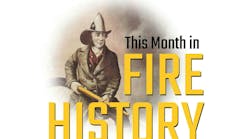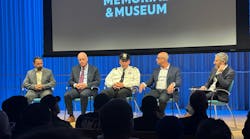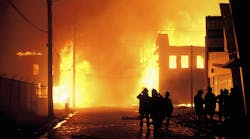As we approach the first anniversary of the murderous attacks upon our nation, I believe the time has come to reflect upon some of the important lessons that have been identified in the past year. You may all remember that I refused to second-guess the operations of the New York City Fire Department during the weeks and months immediately after the incident. I urged you all to remain patient until the investigations began to generate facts that could lead to conclusions and recommendations. The time has arrived to see what we can learn from the operations in New York.
I will be concentrating on the operations in New York. However, you should remember with equal reverence the loss of those folks at the Pentagon in Virginia, and the crash in western Pennsylvania. There are many parts to that sad day known as 9-11.
Let me make my first statement about this as simple as I possibly can. Bravery is never enough. Regardless of the naysayers and detractors, no one will ever be able to convince me that any of the lives that were lost, were wasted.
I am sure that we would rather have them in the firehouse kitchen, telling war stories, but in any war there are casualties, and make no mistake about it: we are at war. I want to say, with a certain amount of sadness, that we are waiting as a nation for the other shoe to drop. What we must do is work to minimize the number of casualties when the cowardly bastards, that live in caves and eat dead rats, come at us again.
The FDNY has a long history of dedication and heroism. I was sickened by the ranting of a particular editorial writer who portrayed the departed members as cowboys running rampant through the towers. It is amazing people that have never faced a life and death situation are so quick to condemn those who do it as a matter of course.
Maybe there could have been a better system of operational control. I am not the one to say that because I have never experienced an operation of that magnitude. Each plane crash I attended in the U.S. Air Force involved planes and the earth, no buildings.
It is sad to say folks, the bravery of our troops that we seemingly take for granted, must be supported by the necessary technical and operational support. Our politicians and citizens must be made willing to pay for those tools that will make our task easier and safer. The results of the study conducted by an outside consultant are in, and I have been able to review them.
The report on the 9-11 operations published by McKinsey & Company is sending a strong message to the world. This message must be reviewed and understood by all who are willing to look and listen. We must change a number of things. Guts and pride cannot overcome a lack of effective planning, technologically advanced equipment, and well-trained forces.
As I read my copy of that important report, which I downloaded from the FDNY website [McKinsey Report], a number of things jumped out at me. I began to think that I had seen a number of the things that were mentioned. Some old lessons were once again brought forward for me to study: Lessons that had not been learned.
There were issues of operation control, accountability, and a lack of interagency cooperation. An incident of this magnitude stresses even the most well drilled incident command system. However, the report calls for an increased emphasis on the use of ICS.
In the months since the tragedy, both the fire and police department have taken steps toward working more from a common sheet of music. As one who follows the New York scene on a daily basis via the media, the stories of the battles and lack of cooperation between those two agencies has been the fodder for many television news shows. That may have played a negative role on September 11.
The report also states that far too many high-level fire officials went to the incident, many without a defined role to play. Think about it gang, we all want to make the "big one" when it happens in our town. In many cases we perform just like the moth that is classically known for being attracted to the flame. We need to specify who attends and who staffs the emergency operations center at a location distant from the emergency.
Perhaps one thing among others stands out as an event similar to many that I had experienced over the years. On page eight of the report’s Executive Summary, it makes reference to the fact that when the WTC 2 collapsed, the battalion chief at the WTC 1 operations command post issued an evacuation order over his portable radio. Given the history of portable radios in high-rise operations, many fire personnel never heard that message.
Every one of us that has worked in a major, metropolitan city has their litany of stories about how bad the operational capabilities of their radios always were in certain places, and at certain times. The same holds true for those of us who perform our lifesaving duties in suburban and rural areas. You just cannot use our current generation of portable radios in any building filled with masses of structural steel and concrete.
Let us work to improve the system and not deride the deceased. Let us remind the world that certain problems existed before September 11, 2001. I know that they have been well documented, for I have harped on them for many years now. I also look to my hero when it comes to high-rise firefighting and structural collapse issues.
The written record of retired Deputy Chief Vincent Dunn of the FDNY lays out the problems inherent in any high-rise situation. I can recall any number of articles that he created over the years which told us the story of our problems in a most convincing manner. They were convincing for us in the fire service, but our politicians and the general public didn’t seem to care.
On May 11, 2002, Chief Dunn sent a particularly strong letter to Mr. Tom Ridge, the President’s homeland security advisor. He spoke of the critical need for such things as:
1. A portable radio that will work in a high-rise building.
2. A smart turnout coat to warn firefighters when the temperature rises to an unsafe level
3. A system to track firefighters in buildings
4. Devices to detect potential collapse scenarios
5. Helicopters and better fireboats for major cities
6. Better self-contained breathing apparatus
7. Better elevators for fire department use
8. Computerized virtual reality training systems for fire command personnel
9. Robot firefighters - Just like there are robot bomb disposal units
Let me state for the record that I strongly support Chief Dunn in his efforts to improve the technology that supports our firefighters in their critical battles. My question is simple. If we can talk to the astronauts out in space, how come my Deputy Chief and I could never talk to each other in the high-rise buildings in the City of Newark, New Jersey? We have been bitching about radio performance since I was a young rookie hanging off of the back of a pumper in the 1960’s.
The military now has system that can tell the military commander where his troops are on the battlefield. How come I cannot track my troops in a two-story residential house?
Far too many people do not take training seriously. I want you to know that I speak not only of skill level training. The command staffs of our fire departments must conduct command post exercises to insure that the necessary operational support system is in place, well-drilled, and functioning when they are needed. This element was also addressed in the McKinsey Report.
This whole situation with regard to structural issues at the World Trade Center incident is going to be particularly difficult to assess. It is an issue unto itself. We must remember that It is the sheer uniqueness of the event that makes it hard to generalize the potential for changes in large-scale operations.
I want to strongly suggest to you all that it is the actual performance of the structure itself during the incident that raises many questions. Many critical lessons for future code changes must, of necessity, come out the investigations being done by various engineering and architectural groups. There has to be a better way to build these big buildings.
We must remember the lessons of the past. I learned many lessons when I worked with the late Commissioner and Chief of the FDNY, John O’Hagan during the 1980’s. It was one of his great beliefs that the building codes allowed new high-rise buildings to be built that were not as structurally sound as the older models built during the early to mid point part of the 20th Century.
You need only look back to the incident where a U.S. Army Air Force B-25 Bomber flew into the Empire State Building back in 1945. There were a number of deaths among the crew and the building staff. However, when last I visited New York City, I saw that the Empire Station Building was still standing majestically in mid-town NYC. I believe that we can attribute that to the fact that there are tons and tons of steel and concrete in that magnificent edifice.
Why is this? Not being an engineer, I cannot give you formulas and equations. However, as a guy who studied building construction and went to a few high-rise fires in a big city, I can tell you this. They just don’t build them like they once did.
On those occasions when I teach high-rise firefighting courses, I use a simple analogy to describe what I really believe a modern, central core high-rise building to be. I tell my students to think of the building as they might think of a cheap, artificial Christmas tree. Think of how you place the upright pole into the base. Then think of how you stick the branches into the slots in the pole. You then fluff up the branches to make it look like a tree.
That is the problem with the newer high-rise buildings. Code changes were made to allow the builders to create cheaper structures that met the new performance codes. Rather than encasing steel in concrete, let’s just spray some fireproof stuff on the steel and call it fireproof. It is like all of the floors are hanging off of the core, wrapped in a skin that keeps the water off of the workers in the offices.
I am sorry gang, but let me now state the obvious. If I anger some really important people in high places, so be it, but my butt is on the line just like yours, because I still go to fires. We in the fire service are suffering because of a couple of things:
1. Too much money spent buying off politicians
2. Too much money spent by the builders to buy off the code process
3. Not enough money spent on research to make our firefighting tools work
4. Not enough money spent of staffing our fire departments at a safe level
5. A greater concern with how many people we send to fires than with how they are trained
6. A lack of proper strategic planning for fire department deployment
7. A willingness to fight this centuries fire wars with the tools and tactics of the last century
8. A willingness on the part of our people to accept death as a mandatory job requirement
There should be enough in the last several lines to anger just about every aspect of the American fire service. However, unless we come together as a fire service and work in a concerted way to address these concerns, I suggest that we are just marking time until the next large-scale disaster.
Bravery is never enough. We need to come together as a national fire service. We need a plan. We need federal money. We have to work in a focused manner that addresses all of the technical and tactical aspects that make up this thing we call firefighting. As Walt Kelly once stated in his magnificent Earth Day Pogo cartoon strip in May of 1971, " - we have met the enemy and he is us."
Above all, Bravery Is Never Enough.
The commentary in this column does not necessarily reflect those of Firehouse.Com, Firehouse Magazine, their employees or parent company Cygnus Business Media.
Harry R. Carter, Ph.D., MIFireE, is an internationally known municipal fire protection consultant and contributing editor to Firehouse Magazine. He recently retired as a Battalion Commander with the Newark, New Jersey Fire Department. His commentary appears regularly on Firehouse.Com. For more commentary and information, visit Carter's web site at www.harrycarter.com
Harry has published several books available for online ordering, including Firefighting Strategy and Tactics and Management in the Fire Service
Content © Copyright 2000 - 2002 Harry R. Carter, Ph.D., L.L.C.





